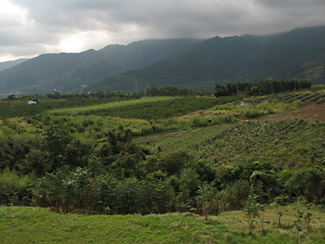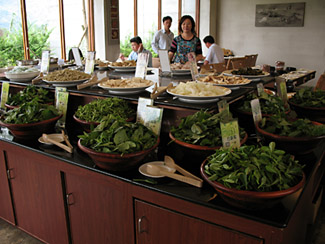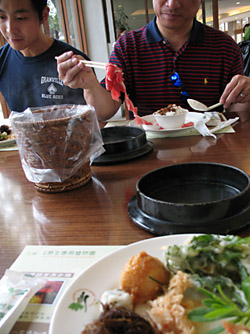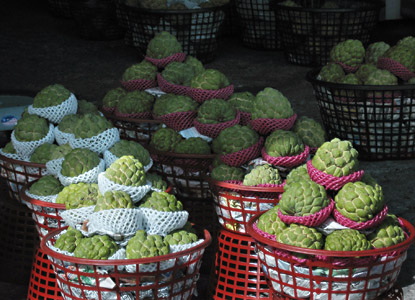Day 1: Tooling around Taitung
 |
 |
"Applied" means not only are the plants beautiful to look at, they are used in soothing spa treatments, in various medicines and food products at the gift shop, and the best part: in the wonderfully light and refreshing buffet.
Lunch was hotpot, my dad's perpetual favorite, with individual bubbling pots and temperature controls at each seat. The meat came from animals raised on the grounds and the herbs & veggies were from the garden right outside. Servers gave brief introductory tours of the selection, informing us that greens should only be cooked for 10-20 seconds to retain all vitamins.
 There was a great selection of fishcakes/fish paste, chewy pumpkin and taro squares, tasty noodles, inaru sushi and surprisingly delicious tempura-fried leaves. Lots of fragrant sauces available, like sha-cha (a Chinese take on barbecue), soy sauce with green onions, fish sauce, chili sauce, and raw eggs to add to the broth. Dessert was delicious fruit-flavored cookies with a glutinous rice (magi, or mochi as Japanese pronounce it) filling. Overall, an excellent and unique meal.
There was a great selection of fishcakes/fish paste, chewy pumpkin and taro squares, tasty noodles, inaru sushi and surprisingly delicious tempura-fried leaves. Lots of fragrant sauces available, like sha-cha (a Chinese take on barbecue), soy sauce with green onions, fish sauce, chili sauce, and raw eggs to add to the broth. Dessert was delicious fruit-flavored cookies with a glutinous rice (magi, or mochi as Japanese pronounce it) filling. Overall, an excellent and unique meal.
The tour was OK; I noted we only saw a fraction of the garden. The garden's guide explained a few herbs' preparation and purpose: some for stomach ailments, cramps, respiratory problems. I had trouble believing that some could be used against actual injuries, but since it was mentioned, my mom mentioned that Chester had twisted his ankle. During an unnecessarily long tour of the gift shop, the guide insisted he try their special medicine (an herbal cream). He was reluctant, but upon leaving she gave him a free sample because she seemed to genuinely want him to feel better. The garden costs 350NT to visit ($10), less without the meal.
Next we went to the Beinan Cultural Park, a prehistoric settlement which at 300,000 square yards contains the largest burial site in Southeast Asia. Discovered first under Japanese occupation, then further explored when the construction of the Taitung Railway station unearthed more relics, the site now features an actual excavation site that visitors can walk through to see the work in progress. The park included a museum dedicated to the development and culture of Taiwan's indigenous Puyuma tribe, and a beautiful view of Taitung from the overlook.
 Chester and I spotted a native Taiwanese fruit we've never even heard of sold in stands along the road—shi-ja. The name means "Buddha's fruit," because the shape and various overlapping bumps resemble the Buddha's head, but in English it is known as custard apple. When Chen Chih-How realized we'd never tried this specialty of Taitung, he ran out and got some extra-ripe ones for free. They were absolutely delicious, incredibly sweet and mushy.
Chester and I spotted a native Taiwanese fruit we've never even heard of sold in stands along the road—shi-ja. The name means "Buddha's fruit," because the shape and various overlapping bumps resemble the Buddha's head, but in English it is known as custard apple. When Chen Chih-How realized we'd never tried this specialty of Taitung, he ran out and got some extra-ripe ones for free. They were absolutely delicious, incredibly sweet and mushy.
Our final stop was a sign that Taiwanese tour agencies both do not know either what Westerners want to see or what natural beauty lies around them: we went to Pipa Park to ride tandem bikes. I was mystified at why anyone would want to ride around a pretty but fairly ordinary park in a foreign country, but luckily it was over soon.